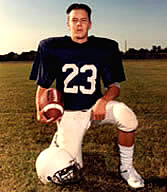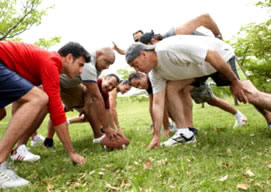Thomas J. Parr, M.D., F.A.C.S.
| |||||
| WELCOME • ABOUT DR. PARR
• PATIENT INFO • en español SPORTS MEDICINE • ARTICLES/LINKS • CONTACT US • PAY YOUR BILL ONLINE |
|||||
|
|||||||
FootballNothing is more “American” than football. It permeates our environment from before the summer training camps open until after the blogs finish discussing the Super Bowl® commercials in February. Make no mistake: football is a collision sport, for which the average American buffalo is better physically prepared than the average American teenager. Every year, over 185,00 children ages five to 14 receive treatment in hospital emergency rooms for football-related injuries. FOOTBALL INJURIES: More injuries occur during practices, but when considering the amount of time spent in practice as opposed to the amount of time spent on the field, the rate of injury is higher during games. Athletes always play harder and take more risks under game conditions. KNEE INJURIES: While isolated sprains of the medial collateral ligament, (MCL) generally do not require surgery, anterior cruciate ligament (ACL) tears frequently do, and some posterior cruciate and lateral collateral (PCL and LCL) ligament tears will require surgery. In addition, meniscus tears and damage to the joint cartilage are quite frequent, and, although they do not seem at the time to be as severe as ligament injuries, they can significantly affect the mechanics of the knee. Few football players who have cartilage repair surgery in high school or college make it into the pros. Strains of the hamstring muscles, even if mild, can take a football player out of play for quite some time. Ice, compression, and rest treat this best. Gentle, frequent stretching helps recovery. Often, the only training that is not painful is the exercise bike and running backward A direct impact to the front of the thigh can result in a quadriceps contusion. Depending on the severity of the injury, it can take from a few days to more than 3 months to get back to training. A thick covering called fascia surrounds the muscles, and fills with blood after a direct blow. This is painful and can significantly limit the ability of the muscles to function. The quadriceps also can be strained, just like the hamstrings. Ice, gentle stretching, and compression are important. Early motion helps prevent stiffness. ANKLE SPRAINS: SHOULDER INJURIES: Shoulder dislocations involve the ball and socket joint of the shoulder, and are typically reduced (put back in place) on the field by the trainer, coach, or doctor. If the shoulder can’t be reduced, the player is usually sent for reduction in the emergency room. Traumatic shoulder dislocations almost always need surgery if the athlete plans to return next season, but conservative treatment is often effective, and surgery can usually wait until after the season is over. HEAD INJURIES: There was a long-held belief that if the player didn't lose consciousness or act confused, it was OK to let him go back in to the game. This is incorrect and is potentially very dangerous. Traumatic brain bruising and swelling can be difficult to evaluate on the field. As we have learned more about concussions, which are a form of traumatic, brain injury (TBI), the more concerned we have become about our inability to quantify exactly when it is safe to return to sport after injury. TBI is not just a mechanical injury problem - the basic metabolism of the brain is affected, to include a chemical imbalance of calcium and potassium ions, and the blood sugar, as well as damage to the microcirculation of brain tissue. Depending on the severity of the injury, these imbalances can last minutes to weeks! While this metabolic imbalance exists, the athlete will have trouble processing thoughts, affecting memory and reaction times. TBI victims can develop irritability, forgetfulness, and recurrent headaches, sometimes after only one injury. These continuing symptoms are called Post Concussion Syndrome, and can become much worse with repetitive trauma, especially if the brain has not completely recovered from the previous injury, because the recently injured brain tissue is especially vulnerable. Pediatric age athletes take longer to recover from TBI than older athletes, and the consequences of repetitive injury on a growing brain can be devastating. A number of published guidelines are available to help coaches and trainers might be safe to reenter competition, but we simply do not have accurate, reproducible tests to determine when it is completely safe to return to sports. The consensus today is that there is no good reason to let a pediatric athlete return to the sport on the same day that he or she sustained a head injury that produced any level of altered consciousness. Even heat trauma can produce a permanent second injury to the brain. Those working with athletes should be quite concerned about any head injury which causes headache, dizziness, blurred or otherwise impaired vision, ringing in the ears, confusion, poor balance, any numbness, tingling, or weakness, amnesia, nausea or vomiting. Call an ambulance and transport the player to an emergency room for further medical evaluation as soon as possible for any of these symptoms following a head injury. The best teams all use a baseline thinking and reasoning test to use for comparison when trying to decide when to return an athlete to play. BACK & NECK INJURIES: “Stingers” are shooting pains into the arms and sometimes into the legs. They result from a direct blow or stretching injury to the neck. These last only a few seconds and go away spontaneously, but can lead to permanent injury. These can be a harbinger of much more severe injury to the neck and players must be instructed to report stingers, especially if they occur more than once. “Ruptured” (herniated) discs and fractures of the spine can end a player’s career. To a large extent, neck and back conditioning and strict enforcement of proper tackling and blocking techniques can prevent these. The "no-spearing" rule in the late 1970s led to a dramatic reduction in catastrophic injuries, but severe injuries to the neck still occur each year. Changes in the helmet and shoulder pads have also helped considerably HIP POINTERS: HEAT INJURIES: When the humidity is too high, water on the skin cannot evaporate as efficiently, making the outside temperature seem much higher than it is. For example, if the outside temperature is 86 degrees F, and the relative humidity is 90% (Not uncommon in Houston) the outside temperature will affect the body as if the temperature were actually 105F! The coaches and training staff need to know how to calculate the heat index, so they can modify their training schedule appropriately. The National Weather Service provides a simple online calculator to help with this, The best fluid to protect oneself when exercising in the heat is water. You do not usually lose enough salt to warrant adding salt to your drink. The popular sports drinks are tasty, but water is your best friend most of the time. Heat injuries can cause permanent damage to the nervous system, and to one’s ability to regulate his or her body temperature for quite some time. At the first sign of heat cramps or exhaustion, get the player to a cool shady spot and start providing fluids. Get as much clothing off as practicable, and use fans. If the player seems confused, nauseated, or lethargic, call EMS. Football is a wonderful sport, and, with proper coaching, equipment, and supervision, it can be enjoyable and relatively safe for all participants. — Tom Parr, M.D. |
COMMON SPORTS INJURIES & SAFE PARTICIPATION
Baseball & Softball
SPORTS MEDICINE RECOGNITION
Recognized as one of the "Top Sports Medicine Orthopedic Surgeons in the USA" by Castle Connolly. Dr. Parr has been named as an "Outstanding Orthopedic Surgeon of Texas", as seen in SPORTS ILLUSTRATED.
SPEAKER'S PROGRAM:
|
||||||
| 14090 Southwest Freeway #130 Sugar Land TX 77478 Phone: 281-491-7111 |
© Copyright 2009-2018 Thomas J. Parr, M.D. |




